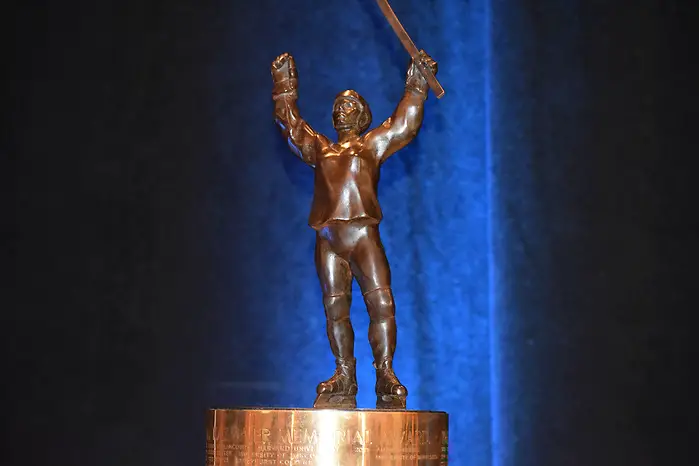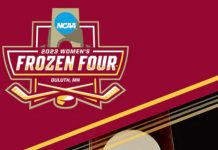
Nicole: This weekend a offered the whole gamut of women’s college hockey experiences. We had top teams Cornell and Northeastern cruise on to the semi-finals, one of the longest games in DI history and an upset I didn’t even think to see coming. I was lucky to stay home this weekend and just endlessly cycle through streams.
Colgate held their own with Clarkson, but simply could not score. Liz Auby was a huge part of keeping them in the game and I wish she could have closed her career differently. Clarkson has now ended Colgate’s season in each of the last three years. If the Raiders are going to stop that trend, they have to find some more dangerous scorers.
It continued to be a season of two BC’s, as Boston College never seemed in doubt on Friday and then couldn’t muster much in the way of offense or self-assuredness on Saturday.
Sixth seeded New Hampshire had no trouble taking down three seed Providence in the Hockey East tournament. While that’s an upset, it doesn’t feel surprising and it was clear the Wildcats didn’t head into the series feeling like underdogs. It seemed like there was no doubt that they’d win and advance.
I was surprised at how well St. Cloud State hung with Minnesota – the Gophers really put them away in the third period of each game, but the Huskies kept it close for quite a while. That series makes me think their struggles this year were more about depth than talent. I think they showed they’re a team worth paying attention to next season.
What did you see in the quarterfinal games that you think was worth noting?
Arlan: For overall trends, all three series where a No. 4 seed hosted a No. 5 seed went to a third game. That’s not surprising, given that we expect those opponents to be the most evenly matched. It might also be a case of trying to make too much of a small sample size, as all three teams from Connecticut went to a deciding game as well, and I wouldn’t try to claim it’s because teams from that state are the most evenly matched.
As for the St. Cloud State at Minnesota series, I wouldn’t say that it was any closer than Vermont at Northeastern as a comparison. If you think that the Catamounts are on the brink of better things, then maybe SCSU is as well, although I’m not sure what WCHA team looks vulnerable to being passed. I will say that the Huskies improved in team defense this season, at least at times, but that wasn’t really in evidence this weekend. That the scoreboard stayed as close as it did was largely due to some big saves by Emma Polusny, who faced 110 shots on the weekend and performed very well in spite of 11 of them getting by her. The Huskies had some chances to expand on a first-period lead on Friday, when Minnesota was not playing well at all defensively, but after that, they didn’t have many quality chances beyond their goals.
The series for all intents and purposes ended in the final minute of the second period on Saturday. The Huskies cut a three-goal deficit to two and looked like they’d take some momentum to the locker room, but Grace Zumwinkle completed her hat trick just 23 seconds later, and that was that.
That’s not to say that everything looks encouraging from the perspective of the Gophers. Taylor Wente and Catie Skaja, who are two thirds of their third line, are injured, and they are nowhere near as deep up front as last year, when one hardly noticed if a forward or two went missing. Offensively, they need their top line centered by Taylor Heise to score, which they did on Saturday. On Friday, they had as many chances, but looked like they couldn’t hit the ocean from a pier; on the power play, that unit can do a lot of things, but of late, score isn’t one of them. Defensively, the Minnesota skaters need to walk that fine line between getting too aggressive and making losing gambles, and becoming too passive and giving up the zone too easily. Once the puck is in the Gophers’ end, Sydney Scobee has to play like someone who was just named to the All-WCHA First Team and trust herself more than she did this weekend.
As you wrote in your column last week, the conference quarterfinal round brings its own unique flavor of drama, and there is plenty more of that to discuss.
Nicole: Of course, what we didn’t mention was Maine’s two-game upset of Boston University.
Losing this early ousted BU from any chance they had at receiving an NCAA at-large bid and ended their season far earlier than I think anyone had imagined it would.
Maine received contributions from a number of players, but it was rookie Ida Kuoppala, who leads the Black Bears in both goals and points, who scored the game-winner in overtime. Carly Jackson made 84 saves over the two games and Boston University simply could not find a way through. Maine jumped out to a lead in each of the games and was able to settle in on defense, controlling that end of the ice. They played strong defense and frustrated the Terriers and took their chances and opportunities when they saw them. It was a class in how to play against a team like BU.
Arlan: If I counted correctly, then tournament teams that scored first were 16-2 this weekend in games decided in regulation. It’s always important to score the first goal, but it seems more magnified in the playoffs. Once the game advances to overtime, then it is harder to remember who grabbed the first lead so long ago.
Maine was one of those teams that opened the scoring both days, although they needed OT to win the opener. It may have worn on the Terriers, a team that knew how much was riding on getting some tournament wins, to have to play from behind and never enjoy a lead all weekend. Unfortunately for BU, a season that saw it return to contending status ends when it suffers only its second sweep and seventh and eighth losses of the campaign.
The overall picture in Hockey East is similar to what it has often been over the years: one excellent team pursued by a pack of good teams that aren’t quite at the same level. New Hampshire had Frozen Four teams in 2006 and 2008 when the rest of the league couldn’t really challenge the Wildcats. After a period where both BU and BC were national contenders, and the Terriers reached the national championship game in 2011 and 2013, BU’s program receded after the graduation of Marie-Philip Poulin. That left the Eagles as the conference’s power team, one that dominated in conference play, but wasn’t tested to the same level as champions of ECAC Hockey and the WCHA.
Today, Northeastern is the clear power in the conference, but the next half dozen teams are all at a similar level. Three of the quarterfinal hosts were upset, and at least in the case of UNH sweeping Providence and UConn taking down BC, it wasn’t all that surprising. The result is a league final four that looks less balanced than the other two leagues that have more more than six teams. Going by KRACH rankings, the ECAC has No. 1 Cornell battling teams ranked No. 6, No. 8, and No. 11. In the WCHA, the last four teams standing are No. 2, No. 3, No. 4, and No. 7. In Hockey East, No. 5 Northeastern’s highest-ranked remaining opponent in KRACH is No. 20 New Hampshire.
Both UNH and BC had difficulty succeeding at the Frozen Four when they ran into teams that were a level above what they’d been playing in conference. Will Northeastern? At least the Huskies played Wisconsin earlier in the year, so they know that there is another level out there.
Nicole: In game two of the Bemidji State/Minnesota Duluth series, the teams played more than 100 scoreless minutes and yet it was some of the most fun-to-watch and exciting hockey of the season – stomach-turning camera-work aside.
Special teams defense and goaltending were both very good, especially late in the game. Bemidji killed a penalty in the third and two in overtime, while UMD killed two in the third and one in overtime. Lauren Bench had 70 saves and carried a 119:55 scoreless streak into Sunday’s game.
Arlan: Bench’s scoreless streak and Bemidji’s season ended in unglamorous fashion, as the Bulldogs’ Anna Klein scored late in the first period, and they added three quick tallies in the opening 6:09 of the second stanza to chase Bench. After such a heroic effort to extend her career on Saturday, Bench is victimized for four goals on 10 shots in her final appearance for the Beavers. It was a letdown all around for Bemidji State, losing 4-1 in a game that was never in doubt in the third period with Maddie Rooney holding down the fort for Minnesota-Duluth. Hockey is a strange game, where a day can make such a big difference.
The ultimate winner of the action in Duluth over the weekend may be Wisconsin. The Badgers can get their mojo back against a UMD squad that skated for almost 260 minutes of game action this weekend while UW rested. The Bulldogs aren’t a particularly deep team to begin with, but if their legs aren’t back to 100 percent, and I don’t see how they could be, then I don’t know that they can rely on a plan of giving their top two lines heavy minutes next weekend.
In the other semifinal, Ohio State and Minnesota look very evenly matched based on their season series. If that is a battle for 60 minutes or beyond, then it sets up very well for Wisconsin to defend its 2019 Final Faceoff Championship.
You mentioned that No. 1 Cornell had a fairly easy time of it versus St. Lawrence, but the other three series had plenty of drama. A power-play goal each day was just enough to push Clarkson over Colgate, with Friday’s coming 12:28 into overtime. Marie-Pier Coulombe may have been somewhat overshadowed to some extent by the seasons that Lindsay Browning and Aerin Frankel have put together, but she’s not far off statistically and has kept Clarkson in the national tournament picture.
Each of the two remaining ECAC series went to three games, the final two needing overtime to determine a winner. Visiting teams Quinnipiac and Yale came from behind to force overtime with late extra-attacker goals on Sunday. Although Princeton and Harvard ultimately prevailed in two and three overtimes, respectively, the underdogs definitely gave the favorites a series to remember.
We’ve talked over the years about how we wish that we could experience the ECAC Tournament in person. What did you like about that league’s quarters this year?
Nicole: Well they didn’t disappoint. Five of the ten games played went to overtime. When I interview players and coaches for my column over the course of the year, folks from the ECAC are the first to talk about parity and how you cannot take a night off. While I think at this point that’s true across the board, it does seem particularly poignant in the ECAC.
Quinnipiac has been in the national rankings on and off all season and was just the seven seed in this tournament and they pushed Princeton to the absolute brink. That 2 OT game three was one of the most interesting games I’ve watched in awhile because Princeton tightened up and was down to essentially playing two lines focused entirely on offense. On the other side of the ice, the Bobcats, who are a defense-first team, were able to keep rolling three lines fairly regularly. It came down to an odd-player rush and a rebound no one was around to clean up for Princeton to win.
I watched portions of every one of those series, which I don’t think I can say about any of the other tournaments. I tried to check in on everything this weekend, which is pretty impossible, but these were the games that had me hooked and I was switching between the Harvard/Yale and Quinnipiac/Princeton overtimes on Sunday. We’ll see if all that extra hockey has an effect on teams this weekend
The CHA regular season ended with more of a whimper than a bang as both Mercyhurst and Robert Morris lost on Saturday, giving the Lakers the win by a single point. The opportunity was there for the Colonials, but they couldn’t take advantage and their 4-2 loss to Syracuse meant Mercyhurst took the crown. The rather uninspiring end to the season doesn’t give me much hope for the CHA tournament winner in the NCAA’s.
With so much fizzle there at the end, what do you expect to see out of the CHA tournament? Will Mercyhurst double up on titles and get the auto-bid or do you think someone else makes a run for the tournament championship?
Arlan: A few weeks ago, you asked me who would win the CHA season title, and I fell back on the tried and true method of picking Mercyhurst. The Lakers did win, but it was because they held a one-point lead at the point that I picked them. Nobody holds a lead now. Robert Morris and Mercyhurst receive quarterfinal byes, but teams that automatically advance to the semifinals have only won the CHA Tournament Championship in half of the last six years.
I find it hard to believe that either Lindenwood or RIT are sitting on a championship run. It’s the CHA, so either one can spring a quarterfinal upset, and maybe even back that up with a surprise win in a semi, but that’s it. I don’t think either has what it takes to win three straight. Penn State struggles to score when it isn’t playing Lindenwood or RIT; of late, it has been netting about a goal per game against the rest of the league. That’s not enough to win it all.
With the other three, you can just about flip a coin, although I guess that doesn’t work with more than two possible outcomes. Okay, roll a dice after assigning a couple of numbers each to Syracuse, RMU, and Mercyhurst. It’s got about a one-in-three chance of being right, and I doubt that I’ll do any better, but I’ll pick the Orange. Goalie Allison Small has the best save percentage and goals against average in conference play. Despite not having a top scorer like the Colonials and Lakers do, Syracuse is right there as a team when it comes to scoring goals.
Nicole: Clarkson’s Elizabeth Giguere, Northeastern’s Aline Mueller and Wisconsin’s Abby Roque were announced as the Patty Kazmaier Award top three finalists on Tuesday.
I thought we might see a goalie in the top three this year. The two nominees are both very good and there’s not a lot to separate them, which makes it difficult for committee members to pick one or the other. For me, Frankel seemed like the choice between the two goalies because she doesn’t have the defense in front of her that Browning does at Cornell.
I also think there’s a very high threshold for goalies for this award. Forwards need to merely separate themselves within that year. Goalies seem to have to measure up to everyone historically and come out ahead. Only three goalies have ever won and I think one of the reasons Ann-Renee Desbiens felt like a clear-cut choice for the top-3 that year is that a lot of the records she broke belonged to the last goalie that had won it before her, Jessie Vetter. Any future goalie candidates for the award will be measured against Desbiens. It’s an odd quirk of the way voting seems to go for the award, I think.
There have only been a few times in the history of the award where the winner didn’t come from a Frozen Four team that was ranked in the top 4 come season’s end. Clarkson is currently ranked 7th and is not yet assured of a spot in the NCAA tournament, so we could see some unusual or interesting history there. Voting has already concluded, so it’s not as though whether or not they make the tournament will matter, but it would be a different precedent. You never know what committee members take into account when voting and Clarkson’s bubble position may affect Giguere’s chances.
There were plenty that were surprised that Roque made the top 3 over Watts, who is the nation’s leading scorer. I’ve talked a lot about those two, so I’ll let you tackle that one.
What do you think, did the committee get this right?
Arlan: The way that I would rationalize the Kazmaier top three is that the committee collectively tried to select the best player, or player season, from each of the conferences that had finalists. Some years, the votes get split and that’s how it works out. There are any number of ways that the voting could have gone differently. Do I find fault with this list? No. Do I think that this was the only acceptable top three? No. I think that this is a year where different committees could likely have recognized different players, and it was just that type of season.
Who was potentially slighted with the selection of this trio? The Cornell players. The Big Red have emerged as the top team, and they don’t have a finalist. There are a number of precedents for this over the years.
Watts was also left out. Perhaps her omission is partly a result of her transfer during the offseason. Not from a punitive sense, but because she had to start over, both on a new team and in a new conference. Meanwhile, Roque has been building her resume for four years, and anyone who has ever tried to win a puck battle with her along the rail knows that she brings abilities to her game far beyond her snipes and dangles. There are reasons why upperclassmen in general and seniors in particular have done well in the voting over the years. The candidates were likely close enough that it was always going to be tough for one team to place more than one player in the top three.
While I might have expected Frankel to have the best shot of the Northeastern duo, she didn’t separate statistically from Browning, who helped her team to a slightly better season.
Ultimately, the committee picked three great players, and I don’t begrudge anyone her spot. The problem with any award, in sport, art, or what have you, is that there are typically more people deserving recognition than awards available. So it is here.
Who wins? Let’s save that question for a couple of weeks.


